
Records of records
I’ve been thinking about numbers lately. Not in a Jewish, gematria-type way, but in a way that kinda makes me wish I had developed my quantitative reasoning skills. If I had, I’d be a bit better prepared for life moments like this…
When I was at Brandeis, I was required to take a course for “Quantitative Reasoning,” which ended up being something about the history of scientific innovation. In other words, it was a course designed for people like me, who got itchy thinking about integers.
But when the organization you’ve been employed by for the last seven years turns 15 years old, you start to consider a lot of numbers. The number of programs and services delivered, the number of partners in our region, the number of staff over that number of years. In an organization that has grown so much, in a region that is so large.. well, all that number-crunching is what I like to call a “special project.”
So where to start?
Well, where would you start? Think about your own workplace- who’s keeping up with the daily ins and outs of your organization? Who in your family or among your friends is keeping records of important life moments? Do you have someone that holds all the institutional memory?
Most of us rely on digital assistance these days — large archived email lists, folders of uploaded photos. But collecting all this data for work has gotten me thinking about the importance of archives! (Hey, I’m a museum professional, what did you expect?)
Our museum collection is filled with records from Southern congregations. These records are incredible resources for looking back into the everyday lives of Jewish communities. Minutes from sisterhood meetings, confirmation photos with names carefully handwritten on the back, ledgers with all the members and when they paid their dues, newsletters that include gems like the rabbi’s sermons and welcomes given to guests to town. Groups that have a designated secretary often embody record keeping at its finest.

Records from passover seders in Meridian, Mississippi in 1899 and 1906 listing the guests in attendance, weather that day and notes about the “amusements of the phonograph”.
The primary source documents are precious — and the documentation that goes along with preserving everything in an archive is just as important as the items themselves. As a museum registrar, I’ve got filing cabinets filled with records about records, digital files and images on all the objects in our collection. Collections management is essentially that fine balance of not only preserving objects but also creating and maintaining documentation to provide accessibility and accountability to the interested public, and to ensure that their meaning and origin is not lost.
All that to say, because the ISJL provides such a wide range of services to a variety of audiences, each department has been maintaining data in their own unique way. To commemorate our 15th year, I’m starting on a project to develop a common institutional memory, a system where we can access when we had programs in Montgomery, Alabama over the last 15 years, whose weddings were officiated by ISJL rabbis, and how many people have attended Jewish Cinema South Film festivals. I’ll be looking through old CIRCA magazines, trip reports, conference rosters, digital folders on our common drive… and figuring out the best ways to quantify our impact on this region.
So invite you to join me in this journey into numbers and impact. Take a minute and reflect on what you’ve got archived from the last 15 years of your life. What would your numbers be? How would you quantify the impact of your life? And how do you quantify your personal Jewish impact? Number of d’vrei torah given, number of matzoh balls made, or number of blog posts written? Looks like I’m already working on my own numbers, and not just my colleagues’ collective contributions!
Like this post?
Join the conversation through MyJewishLearning’s weekly blogs newsletter
.


